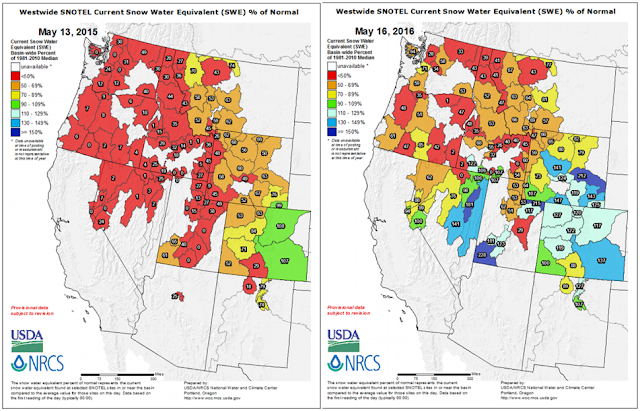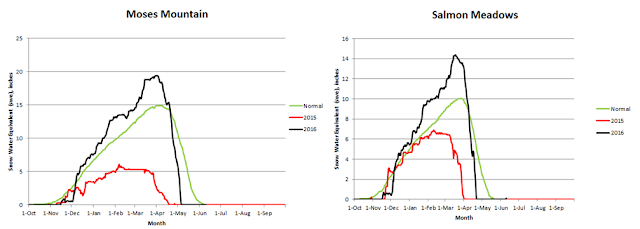Historical Hoopfest
Weather
Data compiled
by the National Weather Service in Spokane. All times are PDT. All data
recorded at the Spokane International Airport.
June
30 & July 1, 1990
June 30 High 83
Low
62
July 1 High
82
Low
55
The first Hoopfest
featured nearly perfect early summer weather conditions, with the basketball
played under mostly sunny skies and temperatures topping out in the lower 80s.
June
29 & 30, 1991
June 29 High 65
Low 52
Precipitation 0.37
Inches
June 30 High 69
Low 50
Precipitation 0.07
Inches
In sharp
contrast to the initial season of Hoopfest, both days of this year’s Hoopfest
featured weather more typical of Bloomsday.
A thunderstorm brought heavy rainfall to the area late Friday night and
early Saturday morning, leaving behind wet courts to start the day off, along
with cool temperatures. The day remained
cloudy with more showers to contend with in the afternoon. Another thunderstorm moved through Spokane
Saturday night between 9 pm and midnight.
Sunday was a cloudy and cool day with a few light showers in the
afternoon. It was windy however, with a
southwest wind blowing at 20 mph and gusty.
June
27 & 28, 1992
June 27 High 93
Low 65
June 28 High 92
Low 63
Precipitation 0.04
Inches
After a cool
and wet Hoopfest in 1991, the 1992 was just the opposite. Hoopfest begin on Saturday morning with
Spokane in the grips of an unusual June heat wave. Just a few days before the beginning of
Hoopfest Spokane set an all-time record high for the month of June when the
temperature hit 101 degrees on June 23.
This hot weather pattern continued right on through the Hoopfest
weekend. Saturday was hot and sunny,
though the high of 93 may have felt better to many considering the hot
temperatures of the days before. Sunday,
while just about as hot, saw in increase in cloud cover ahead of a strong
frontal system to end the month. By 3 pm
thunderstorms moved into the city lasting through the evening.
June
26 & 27, 1993
June 26 High 90
Low 55
Precipitation 0.04
June 27 High 69
Low 52
Saturday saw
hot temperatures and full sunshine ahead of a frontal system moving into the
city. Late Saturday evening
thunderstorms moved through downtown.
Fortunately the rain fell overnight and by Sunday morning only high
elevation clouds were observed.
Temperatures were much cooler on Sunday, down over 20 degrees from
Saturday’s hot readings.
June
25 & 26, 1994
June 25 High 86
Low 45
Precipitation Trace
June 26 High 65
Low
49
Precipitation 0.25
Inches
The 1994
edition of Hoopfest saw weather conditions quite similar to the preceding
year. Saturday was a warm and sunny day
with almost no wind. A frontal system
brought widespread showers to the city early Sunday morning. Fortunately most of the precipitation ended
by 5 am. Sunday was a cool, cloudy and
very windy final day of Hoopfest. Winds
blew from the southwest at 20 to 25 mph with gusts over 30 mph.
June
24 & 25, 1995
June 23 High 80
Low 51
June 24 High 85
Low 54
Uneventful
weather marked this year’s Hoopfest, with cool mornings and warm afternoons
under light winds and almost full sunshine.
June
29 & 30, 1996
June 29 High 72
Low 44
June 30 High 80
Low 49
Similar to
last year’s Hoopfest, but with cooler temperatures. Both days were played under full
sunshine. Many would call this the
perfect Hoopfest weather weekend.
June
28 & 29, 1997
June 28 High 78
Low 44
Precipitation 0.01
June 29 High 68
Low 52
Precipitation Trace
Another sunny
Hoopfest day on Saturday with temperatures right at average that
afternoon. Increasing clouds Saturday
night with a brief shower near midnight.
Cooler on Sunday under cloudy skies and southwest winds 10 to 20 mph.
June
27 & 28, 1998
June 27 High 73
Low 47
June 28 High 82
Low 48
Partly cloudy
and cool on Saturday, followed by warmer temperatures in the lower 80s under
mostly sunny skies for Sunday.
June
26 & 27, 1999
June 26 High 64
Low 44
June 27 High 70
Low 45
What a
difference a day makes! Had Hoopfest
been one day sooner then a true washout would have occurred, as Friday was a
wet day with 0.85 inches of rain.
Fortunately the weather system responsible for the wet weather moved on
and Saturday, while unseasonably cool was dry.
Sunday saw another cool day with partly cloudy skies.
June
24 & 25, 2000
June 24 High 74
Low 52
Precipitation Trace
June 25 High
77
Low
49
Saturday
featured mostly cloudy skies and seasonable cool temperatures. A brief shower or sprinkles moved across the
area in the afternoon, leaving only trace amounts of rainfall. Similar temperatures occurred on Sunday but
with much more sunshine.
June
23 & 24, 2001
June 23 High 73
Low 57
June 24 High 66
Low 48
Precipitation 0.02
Inches
This was
another cool Hoopfest. Saturday saw
temperatures in the lower 70s under partly cloudy skies. Sunday was cooler still with cloudy
skies. Light showers moved into the area
by late Sunday afternoon.
June
29 & 30, 2002
June 29 High 72
Low 50
Precipitation 0.27
Inches
June 29 High 71
Low 47
Yet another
cooler-than-average Hoopfest. After
several hot days right before Hoopfest, temperatures cooled off right in time
for the weekend. The frontal system
responsible for the cooler weather also brought with it a period of rain Friday
night and Saturday morning. But as has
been the case in several past Hoopfests, the rain ended right at 5am Saturday
morning, leaving behind cloudy, cool and windy weather for Saturday, but
fortunately no rain! Sunday was a cool
day under mostly sunny skies.
June
28 & 29, 2003
June 28 High 88
Low 55
June 29 High 93
Low
57
The streak of
cool temperatures on Hoopfest ended in an abrupt manner for the 2003
Hoopfest. Saturday was a hot and sunny
day more typical of July. Sunday was
even hotter, with blistering temperatures in the 90s. The high temperature of 93 tied 1992 for the
hottest Hoopfest temperature, which would later be broken in 2008.
June
26 & 27, 2004
June 26 High 78
Low 62
Precipitation Trace
(Thunderstorms)
June 27 High 81
Low 57
Thunderstorms
were the main concern for Hoopfest on Saturday.
By late Saturday morning, thunder and lightning was observed very close
to downtown. One thunderstorm brought a
brief downpour to the event around lunchtime, but fortunately the heaviest rain
from this thunderstorm moved just north of downtown. The storms decreased by afternoon, leaving
the rest of Hoopfest dry with seasonable temperatures, though a little bit on
the muggy side for Spokane.
June 25 & 26, 2005
June 25 High
79
Low 57
June 26 High
80
Low 54
Ideal weather
conditions greeted this year's participants, with mild temperatures and some
high clouds both days. The 2 days after Hoopfest were markedly different. Both
had around a third of an inch of rain with temperatures only in the mid 60s.
June
24 & 25, 2006
June 24 High
84
Low 50
June 25 High
90
Low 57
Warm
temperatures on Saturday gave way to hot readings on Sunday. Hoopfest players
and spectators were treated to abundant sunshine on both days.
June
30 & July 1, 2007
June 30 High 73
Low 51
July 1 High 82
Low 51
Hoopfest
dodged a weather bullet in 2007. On the Friday before the start of Hoopfest,
strong thunderstorms rumbled through the Spokane metro area bring rain, hail,
damaging winds and lightning. But the storms moved out of the area by late
afternoon, allowing the final preparations to be made for the weekend's
activities. Weather on Saturday and Sunday was ideal, with only some high
clouds and light winds.
June
28 & 29, 2008
June 28 High
92
Low 58
June 29 High
97
Low 64
The 2008
edition of Hoopfest easily goes down as the hottest Hoopfest yet. The previous
record hot Hoopfest was 93 degrees in 2003 and 1992. The Saturday 2008 reading
of 92 came close, but the Sunday high of 97 shattered the old records. While
this was the hottest Hoopfest temperature (i.e. since its inception in 1990),
there have been highs as hot as 102 degrees during the late June/1st of July
period (see records at the top of this page). In 2008, winds were light and
skies were mostly sunny so there was little in the way of relief from the hot
weather.
June
27 & 28, 2009
June 27 High
79
Low 49
June 28 High
81
Low 55
Unlike the
hot weather in 2008, the Hoopfest of 2009 was held in just about perfect
conditions. Temperatures were around 80 both days under sunny skies. Sunday
even had a nice breeze to keep things from getting too warm.
June
26 & 27, 2010
June 26 High
79
Low 55
June 27 High
79
Low 52
A virtual
repeat of 2009, Hoopfest 2010 had ideal weather for outdoor recreation.
Temperatures were around 80 both days under mostly sunny skies. The winds did
kick up a bit both afternoons.
June
25 & 26, 2011
June 25 High 67
Low 43
June 26 High 73
Low 43
Hoopfest 2011
was cooler than the previous year with the high temperature about 9 degrees
below normal on the 25th warming to only 4 degrees below normal on the 26th.
Clouds were minimal throughout the day on the 26th with a southwest wind to 10
mph. The 27th was sunny with even lighter wind.
June
30 & July 1, 2012
June 30 High 78
Low 60
Precipitation: Trace
July 1 High 78
Low 59
Precipitation: Trace
At first
glance, Hoopfest 2012 was held under near-ideal weather conditions. The high
temperature of 78 on both days was within 1 degree of normal readings for this
time of year. The morning low temperatures were rather mild. But the unusual
part was the humidity, which was rather high for our area. Dewpoints were in
the mid-50s both days. Skies were mostly cloudy, with a few sprinkles, but not
enough to cause any impact to the games.
June
29 & 30, 2013
June 29 High 76
Low 62
Precipitation: 0.06
June 30 High 91
Low 59
Precipitation: 0.00
Saturday,
June 29th started out as a very cloudy day with thunderstorms in the area and
high high dewpoints indicating a significant amount of moisture in the air. The
cloud cover and showers kept temperatures down. The next day on Sunday, saw
drier and much warmer conditions and partly cloudy skies which helped
temperatures recover back to around 90 degrees by Sunday afternoon..
June
28 & 29, 2014
June 28 High 72
Low 52
June 29 High 71
Low 50
Wet
thunderstorms moved through Spokane on Friday evening bringing a
quarter inch of rain to downtown. While this rain played havoc with
evening court preparation activities, the weather for the games was much drier. Saturday morning started with low overcast
skies, but the sun broke through later in the day. Temperatures were mild
but it was rather windy. Sunday saw a little more sunshine but it
continued to be breezy.
June
27 & 28, 2015
June 27 High 102
Low 68
June 28 High 105
Low 73
Hoopfest 2015
took place in the midst of the warmest June on record for northeast Washington
and the North Idaho Panhandle and right in the middle of a historic heatwave
from the 26th through the 30th. Spokane International
Airport recorded temperatures of 102 and 105 respectively, both of which were
daily records. The 105 degree temperature at the airport was also a record high
for the entire month of June as well. Temperatures at Spokane Felts Field were
even a couple of degrees higher than that.

























